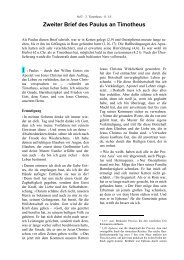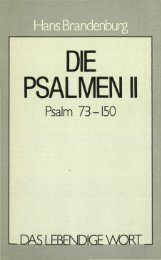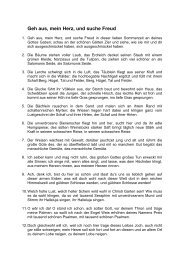You also want an ePaper? Increase the reach of your titles
YUMPU automatically turns print PDFs into web optimized ePapers that Google loves.
The structure of the DNA molecule: Chemically<br />
and structurally the DNA molecule is one of<br />
the most complex and versatile of molecules, a<br />
necessity in view of all its functions. This versatility<br />
is necessary to provide for all its functions. It<br />
looks like a double helix from the outside (Greek<br />
hélix = spiral) comprising two intertwined spiral<br />
strands. Each strand is a long molecular chain,<br />
and the two strands are essentially parallel, intertwined<br />
in a right-hand spiral. The genetic code<br />
comprises four chemical letters adenine (A), guanine<br />
(G), thymine (T), and cytosine (C). Many<br />
genes do not consist of a continuous piece of<br />
DNA, but are made up like a mosaic of several<br />
separated segments.<br />
In all cells, the genetic information stored in the<br />
DNA molecules controls protein synthesis, and<br />
another nucleic acid, ribonucleic acid (RNA), handles<br />
the transfer of all the information. In general,<br />
all cells of an organism contain identical DNA<br />
molecules, but not all genes are active at the<br />
same time in all the cells.<br />
Proteins: Proteins are the workhorses of life. If<br />
we regard the DNA molecule as the blueprint of<br />
life, then the many different kinds of proteins are<br />
not only the bricks and mortar, they make up the<br />
required tools as well as some of them being the<br />
manual labourers which perform the actual construction<br />
jobs. <strong>Our</strong> genes provide the conceptual<br />
foundations (they store the “software”), but we<br />
are what we are (the “hardware”) because of our<br />
proteins. Both DNA molecules and proteins consist<br />
of long chains made up of strings of subunits,<br />
but their functions are fundamentally different.<br />
DNA molecules comprise the genetic<br />
archives. On the other hand, proteins exhibit an<br />
unimaginable diversity of three-dimensional<br />
shapes, reflecting their multiplicity of functions.<br />
Some of the tasks of proteins are that they serve<br />
as structural elements for the body, as messenger<br />
molecules, as receptors for messengers, as individual<br />
cell identifiers, and as substances defending<br />
against cells bearing foreign identifiers. Probably<br />
the most important proteins are the<br />
enzymes, which control the rate of biochemical<br />
processes by acting as catalysts. Certain enzymes<br />
can accelerate some reactions a millionfold or<br />
even more. Enzymes are also indispensable for<br />
the actual process of converting genetic information<br />
into its resultant products and processes.<br />
Structure and chemistry of proteins: Although<br />
there are many amino acids, the Creator chose<br />
only 20 of them from which to construct all conceivable<br />
proteins (and thereby the structures)<br />
necessary for life. In the genetic code, three letters<br />
specify one amino acid, and every protein<br />
consists of an exactly determined sequence of<br />
amino acids. All the physical and chemical properties<br />
of an individual protein are determined by<br />
the length of the chain and the specific sequence<br />
of amino acids. The spatial disposition or folding<br />
of the chain is especially important. Proteins fold<br />
in such a way that the free energy is kept to a<br />
minimum; this means that a protein assumes the<br />
most “comfortable” shape. In principle one can<br />
only deduce the three-dimensional structure of<br />
a protein from the amino acid sequence, if all the<br />
forces acting on all of its thousands of atoms are<br />
known, as well as their effects on the surrounding<br />
molecules of the solvent. Such calculations<br />
are impossible in the present state of our knowledge,<br />
even using the most powerful computer<br />
systems ** . But when the Creator made all living<br />
organisms, He constructed each and every protein<br />
in such a way that all the desired properties<br />
were obtained.<br />
* With a possible inherited (maternal) contribution<br />
from the cytoplasmic structure of the egg cell.<br />
** Remarkably, it now appears that the folding of many<br />
proteins after their construction (which would often<br />
be too slow if left to the physical forces acting on a<br />
particular protein’s components) is aided by specially<br />
tailored ”chaperone” molecules.<br />
79
















